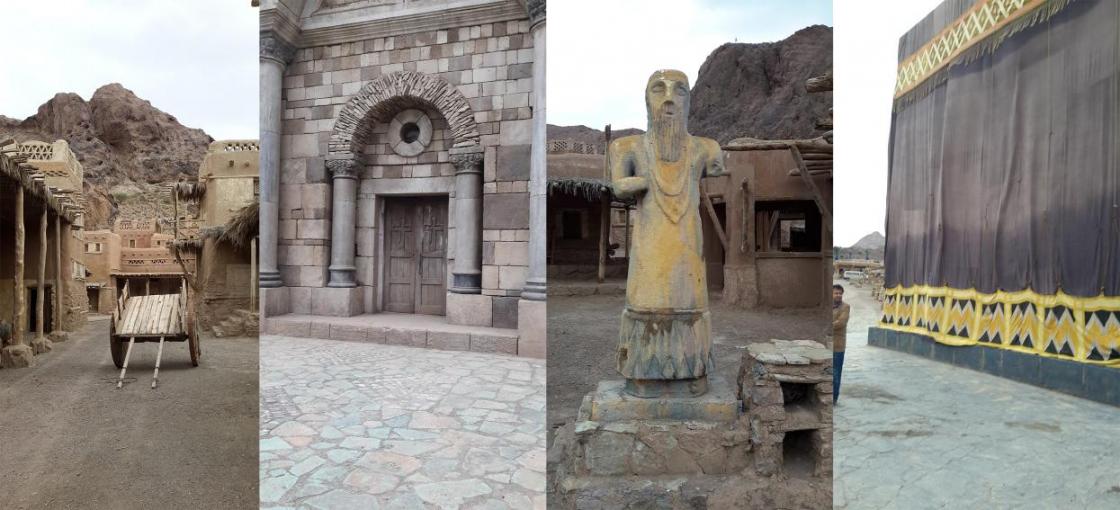Directed by the well-known Iranian filmmaker Majid Majidi, the film ‘Muhammad’, revolving around the childhood of the Holy Prophet of Islam from his birth till the age of 12, marks Iran’s biggest-budget production to date.
On Thursday (January 8) on the sidelines of the 6th National Festival of Prayer in Camera’s View, media persons, including Financial Tribune reporter, along with a group of festival guests made a visit to the location sets of the movie, in a 100-hectare area near the holy city of Qom. The settings are a replica of the 6th century Mecca and Medina during the early years of the Prophet’s life. Majority of the filming was done at the sets. However, certain scenes requiring elephants were filmed at Bela-Bela in South Africa.
The sets, located in a remote area, are away from the main road and between hills and mountains, to let the filmmaking process “be carried in total secrecy and out of the public and paparazzi’s prying eyes.” The natural and serene ambience has also largely helped the production.
The guide explaining about the settings, said the entire 3D town as well as the Ka’aba, the House of Allah in Mecca, was recreated down to the minutest details. In today’s world cinema, visual effects have substituted the making of buildings and places, and even if built, it is just the façade, not the whole construction. However, the city built for ‘Muhammad’ is planned to be maintained and perhaps used for other movie productions as well as serving as a tourist attraction in future.
Resistant but lightweight materials have been used in the sets including the several idols placed at different points in the city, thatch houses, the Ka’aba, an old church, the city gate, a big bell, some carts, etc.
Celebrated Stars
The film has raised high expectations with the involvement of celebrated movie-industry figures from abroad. Italian Cinematographer Vittorio Storaro, a three-time Academy Award winner carried out the filming with a 30-member crew. Another Oscar winner, the American Scott E. Anderson, visual effects supervisor, was employed to undertake special effects design of the military expeditions of Abraha against Mecca in the invasion of Hijaz. Abraha was the Ethiopian general who at that time ruled much of present day Yemen and Hijaz.
Sami Yusuf, the Iranian born British singer/songwriter of the Islamic faith, has recorded a track for the film. The score is composed by Indian Oscar winner A. R. Rahman. Yusuf was probably the best choice for singing the track as he, in 2003, released his debut album ‘The Teacher’ with explicitly religious themes praising the Holy Prophet of Islam and Allah and has since kept religious themes as the focus of his albums.
Other prominent figures contributing to the making of the film include: Croatian Miljen Kreka Kljakovic as production designer, Italian Giannetto De Rossi as make up designer, British Michael O’Connor as costume designer, Gianne Franco Fumagalli as set director, and Luca Lachin as assistant director.
Sequels
The filming started in October 2011 and was completed in March 2014. It is set mainly in the pre-Islamic period of ignorance of divine guidance in Arabia. It starts with the birth of the Prophet and ends when the 12-year-old Muhammad travels to the Levant with his uncle Abu Talib ibn Abdul-Mutallib, where they encounter Bahira: a Nestorian monk who foretold the prophetic future of the then adolescent Muhammad.
Based on the official announcements, the total budget of $20 million was spent on the film.
Internationally known for ‘Children of Heaven’, the first Iranian film to be nominated for Academy Award, Majidi also plans to make two sequels to the first part, making a trilogy on the life of the Holy Prophet, from birth to his demise.
According to Majidi, he and a research team of historians and archeologists had consulted with Shia and Sunni scholars from Morocco, Lebanon and Iraq in order to ensure accurate portrayal of Muhammad’s early years.
The film is set to premiere at the 33rd Fajr Film Festival in the out of competition section on February 1.



